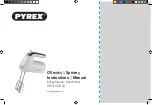
SECTION 1: The Basics Of Digital Mixing
5
C. The Question Of Levels
In the world of digital recording, you have to treat
levels with a little more respect than in analogue
systems in order to avoid distortion. This is
because of the very different ways in which ana-
logue abd digital systems work.
We know distortion when we hear it, but how
does it arise? Put simply, distortion is an unwant-
ed change in the audio waveform, usually caused
by the clipping of the audio waveform. As you
crank up input levels, you reach a point where the
system cannot recreate at the output the extreme
peaks and troughs at the input and thats distor-
tion. In analogue circuits distortion tends to come
on gradually, increasing in severity as input levels
are increased. Because it can sound good to the
human ear, some types of analogue distortion
have long been exploited in the studio to warm
up drum sounds by recording hot to tape, by
using tape saturation characteristics. So, although
the point at which distortion begins can usually be
quite well identified, you can generally push this
level a little without ruining your recording.
Digital electronics, on the other hand, deal with
a precisely defined range of levels. As you increase
the level going into an analogue-to-digital convert-
er, the numbers coming out get bigger and bigger
until you run out of resolution at the convert-
ers maximum input level, and you have the sud-
den onset of distortion. For reasons which are too
tedious to go into, digital distortion doesnt sound
at all pleasant, and its therefore very important to
avoid exceeding maximum levels.
Metering also works differently. In analogue
mixers and recorders, equipment is designed to
operate at various operating levels, such as
+4dBV (most professional equipment) or -
10dBU, and the relationship between 0dB on
meters and the point at which distortion starts is
not fixed. Also, because distortion comes in gradu-
ally, you can almost always get away with pushing
your meters some way into the red.
In a digital system, metering is relative to
0dBFS, which is the point at which the system has
run out of numbers and you cannot go any higher
without creating distortion. There is no LED on a
bargraph meter above this, because there isnt
anywhere else to go. Because distortion occurs as
soon as you exceed these levels, whenever youre
setting levels bear in mind that even peaks should
not light the red LEDs at the top of the 328s
meters, though this might feel right if youre used
to working with analogue mixers.
D. The Future
Because digital audio technology rides benefits
from progress in the very fast moving area of
computer technology, things are always moving
ahead. From 16 bits and 44.1kHz, weve moved
on to a point where 20 and 24-bit recorders are in
use, some with 96kHz sampling. The need to
move greater amounts of data around means that
new interface standards will appear. Firewire
(IEEE1394) is already establishing itself as a use-
ful transfer protocol in digital video, though it may
soon also be used in audio. Another trend that is
is likely to continue is the use of cheap, powerful
consumer or business computers to run increas-
ingly powerful audio software, software that can
take over more functions previously performed by
dedicated hardware.
Guide.qxd 02/03/1999 11:25 Page 5





































